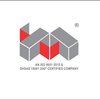Filter interviews by
Ess Kay Fabrication DIE Fitter Interview Questions and Answers for Freshers
Ess Kay Fabrication DIE Fitter Interview Experiences for Freshers
1 interview found
(1 Question)
- Q1. Job relation question
(1 Question)
- Q1. Job experience related question
Interview Preparation Tips
Top trending discussions






Interview questions from similar companies

Trainee Interview Questions & Answers
Millennium Engineers & Contractorsposted on 9 Jun 2023

(2 Questions)
- Q1. Tell me about Concrete
- Ans.
Concrete is a strong and durable building material made from a mixture of cement, sand, gravel, and water.
Concrete is commonly used in construction for foundations, walls, floors, and sidewalks.
It can be reinforced with steel bars to increase its strength and flexibility.
Different types of concrete, such as ready-mix and precast, are used for various construction projects.
Concrete can be colored, stamped, or polished f...
- Q2. What is the IS code for RCC
- Ans.
IS code for RCC is IS 456:2000
IS 456:2000 is the Indian Standard code for the design and construction of reinforced concrete structures
It covers the general requirements for the design and construction of RCC structures
The code provides guidelines for materials, design, construction, quality control, and maintenance of RCC structures

(2 Questions)
- Q1. What is quality
- Ans.
Quality is the measure of excellence or superiority of a product or service.
Quality is meeting or exceeding customer expectations.
It involves consistency, reliability, and conformance to requirements.
Quality can be measured through metrics such as defect rates, customer satisfaction, and on-time delivery.
Continuous improvement is essential for maintaining and enhancing quality.
Examples of quality include a durable smar...
- Q2. Gd&t
Interview Preparation Tips
lage raho
kam karte raho

DIE Fitter Interview Questions & Answers
Pranav Vikas India Private Limitedposted on 31 Aug 2021
I applied via Company Website and was interviewed before Aug 2020. There was 1 interview round.
Interview Questionnaire
2 Questions
- Q1. Family background
- Q2. Education knowledge
Interview Preparation Tips

(2 Questions)
- Q1. Die fitter (hpdc, plastic moulding,press tool)
- Q2. Realted any question
Interview Preparation Tips

(1 Question)
- Q1. Job relation question
(1 Question)
- Q1. Job experience related question
Interview Preparation Tips

I appeared for an interview before Sep 2022.

Easy questions but give short time for question
(5 Questions)
- Q1. 1. TYPES OF DIES 2. What os tolerance
- Ans.
Types of dies include blanking dies, piercing dies, and forming dies. Tolerance is the allowable deviation from a specified dimension.
Types of dies: blanking dies, piercing dies, forming dies
Tolerance is the allowable deviation from a specified dimension
Examples: +/- 0.005 inches, +/- 0.1 mm
- Q2. 1.what is spotting 2.Least count of all measuring tool
- Ans.
Spotting is the process of aligning two or more workpieces accurately before joining or machining. Least count is the smallest measurement that can be read on a measuring tool.
Spotting is crucial for ensuring precise alignment of workpieces in machining processes
It involves visually aligning the workpieces or using tools like dial indicators
Least count varies for different measuring tools, such as micrometers, calipers...
- Q3. What is lapping
- Ans.
Lapping is a machining process used to create a smooth, flat surface on a workpiece.
Lapping involves rubbing two surfaces together with an abrasive and a lubricant to remove material and achieve a precise fit.
It is commonly used in the manufacturing of precision components such as valves, pistons, and gears.
Lapping can improve the surface finish and flatness of a workpiece, making it ideal for achieving tight tolerance...
- Q4. Types of cutting die
- Ans.
Types of cutting die include blanking dies, piercing dies, and forming dies.
Blanking dies are used to cut out a flat shape from a sheet of metal.
Piercing dies are used to create holes in the material.
Forming dies are used to bend or shape the material into a desired form.
Other types of cutting dies include trimming dies, notching dies, and progressive dies.
- Q5. Types of non cutting die
- Ans.
Non cutting dies are used for shaping, bending, and forming materials without removing any material.
Embossing dies
Coining dies
Drawing dies
Forming dies
Interview Preparation Tips
Self confidence is very important
Skills evaluated in this interview

Assistant Manager Interview Questions & Answers
S V S Projects Indiaposted on 15 Jul 2024
(2 Questions)
- Q1. Execution in Structure
- Ans.
Execution in structure refers to the ability to effectively implement plans and strategies within an organized framework.
Understanding the overall goals and objectives of the organization
Developing detailed action plans to achieve those goals
Assigning tasks and responsibilities to team members
Monitoring progress and making adjustments as needed
Ensuring that resources are allocated efficiently
Communicating effectively w...
- Q2. High rise buildings
Skills evaluated in this interview

Software Engineer Interview Questions & Answers
Millennium Engineers & Contractorsposted on 19 Jun 2022
I applied via Walk-in and was interviewed before Jun 2021. There were 3 interview rounds.

(1 Question)
- Q1. What is data structure?
- Ans.
Data structure is a way of organizing and storing data in a computer so that it can be accessed and used efficiently.
Data structures are used to manage large amounts of data efficiently.
They provide a way to organize data in a way that makes it easy to access and manipulate.
Examples of data structures include arrays, linked lists, stacks, queues, trees, and graphs.
Explain logic of stack
Interview Preparation Tips
Skills evaluated in this interview

Civil Site Engineer Interview Questions & Answers
Millennium Engineers & Contractorsposted on 7 Nov 2019
Interview Questionnaire
1 Question
- Q1. Overall process of finishing like tiling, wall gypsum ,plaster,water proofing , with material praporion and there properties
- Ans.
The finishing process involves tiling, wall gypsum, plaster, and waterproofing with specific material proportions and properties.
The first step is to prepare the surface by cleaning and leveling it.
Waterproofing is done to prevent water damage to the walls and floors.
Gypsum plaster is used to create a smooth surface for painting or wallpapering.
Tiling involves laying tiles on the floor or walls using adhesive and grout...
Ess Kay Fabrication Interview FAQs
Tell us how to improve this page.
Ess Kay Fabrication Interviews By Designations
- Ess Kay Fabrication Quality Engineer Interview Questions
- Ess Kay Fabrication QA Engineer Interview Questions
- Ess Kay Fabrication DIE Fitter Interview Questions
- Ess Kay Fabrication Senior Quality Engineer Interview Questions
- Ess Kay Fabrication QMS Engineer Interview Questions
- Ess Kay Fabrication Quaity Control Engineer Interview Questions
Interview Questions for Popular Designations
- Maintenance Fitter Interview Questions
- Fitter Interview Questions
- Mechanical Fitter Interview Questions
- Mechanical Maintenance Fitter Interview Questions
- Assembly Fitter Interview Questions
- Technician Fitter Interview Questions
- Senior Fitter Interview Questions
- ITI Fitter Interview Questions
- Show more
Ess Kay Fabrication DIE Fitter Interview Process for Freshers
based on 1 interview
Interview experience
Interview Questions from Similar Companies
Ess Kay Fabrication DIE Fitter Reviews and Ratings
based on 1 review
Rating in categories
|
Quality Engineer
29
salaries
| ₹2 L/yr - ₹3.5 L/yr |
|
Production Engineer
16
salaries
| ₹2 L/yr - ₹3.6 L/yr |
|
QA Engineer
14
salaries
| ₹1.9 L/yr - ₹4 L/yr |
|
Assistant Manager
13
salaries
| ₹4.6 L/yr - ₹7.5 L/yr |
|
Senior Engineer
13
salaries
| ₹3.3 L/yr - ₹7.5 L/yr |

Millennium Engineers & Contractors

Karam Industries

S V S Projects India

MaRS Planning & Engineering Services
- Home >
- Interviews >
- Ess Kay Fabrication Interview Questions >
- Ess Kay Fabrication DIE Fitter Interview Questions for Fresher












